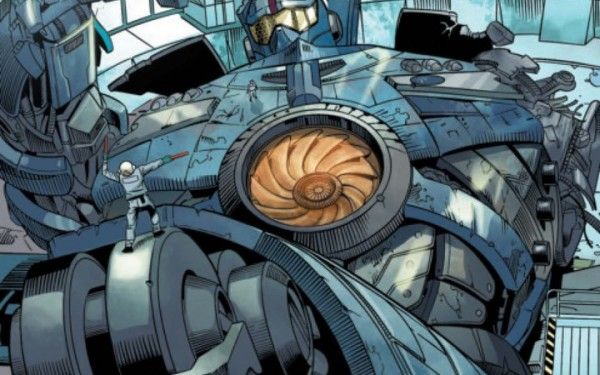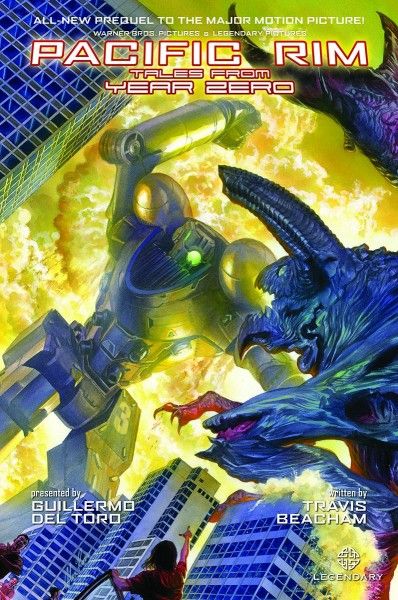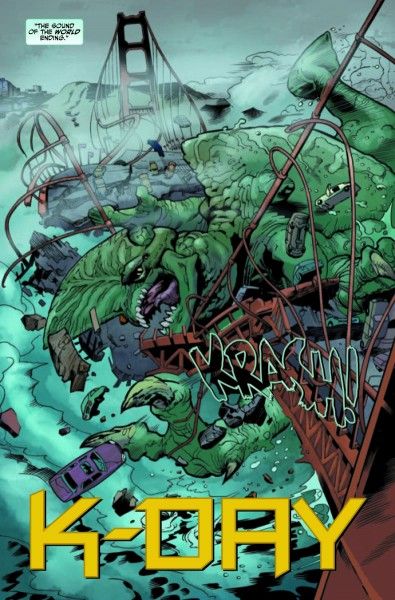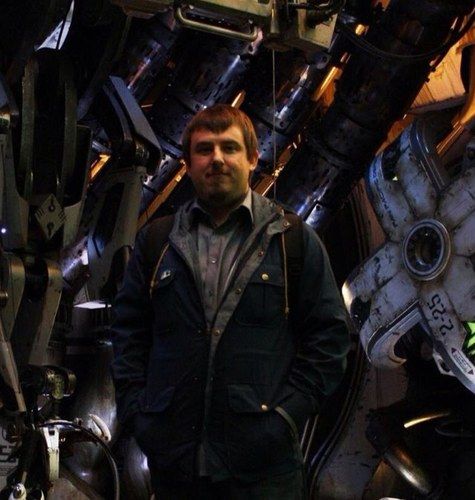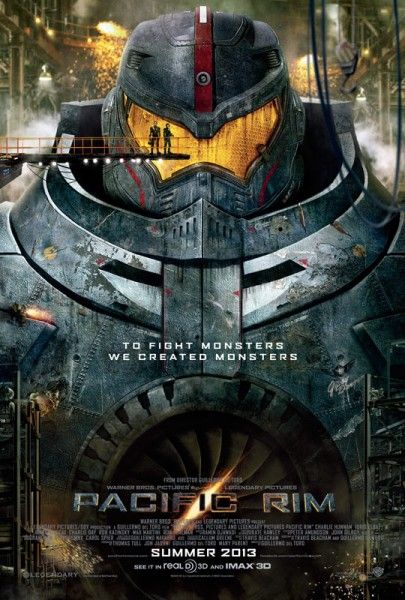Most of the time, if there's some sort of tie-in prequel material, it's just an easy cash-in from the studio. But the upcoming Pacific Rim prequel graphic novel, Pacific Rim: Tales from Year Zero will probably be a must-buy for fans of the movie or those excited for the monsters-vs-robots picture. Year Zero was written by Pacific Rim co-writer Travis Beacham and overseen by co-writer/director Guillermo Del Toro. This graphic novel is straight from the filmmakers.
Last week, I got to do a phone interview with Beacham about the book. We talked about how it related to the development of the script, providing backstories to the characters and the world, the possibility of more Pacific Rim graphic novels, how they might relate to Pacific Rim 2, and much more. Hit the jump to check out the interview. Pacific Rim: Tales from Year Zero will be released on June 18th. Click here to pre-order it. Pacific Rim opens in 3D on July 12th.
I wanted to ask you first about this graphic novel. Where did it come in the development process in relation to the script for the film?
TRAVIS BEACHAM: The process came before the script because, or at least in hand with the script, because we were sort of creating a whole world for the viewer to enter into, and that didn't mean more than what you saw on the screen necessarily, but fleshing out the world that could be referenced or not referenced casually throughout the narrative of the movie. So we had a lot of in-world history, a lot of details, already laid out by the time we started talking about the graphic novel. And when we did, I think the inclination was immediately rather than do a straight-up adaptation of the movie, it would be cool to do something that was additive to the experience of seeing the movie and sort of took advantage of the all the supplementary stuff of the world we had created beforehand. So that was sort of how the graphic novel came about. Usually, it's something that comes after the screenplay, but the story matter in the graphic novel has been part of the world from the beginning.
When creating the script for the graphic novel, did you feel more freedom? Obviously, for a film script you have to keep in mind budgets and what can and cannot be done, but graphic novels give you so much more freedom in what you can create.
BEACHAM: One of the biggest and unexpected luxuries about doing the graphic novel was not so much in the special effects sort of arena because I knew the movie would have as much special effects as it was ever going to need to look really,really cool. But one of the biggest unexpected luxuries of the graphic novel was the luxury of time. You didn't really have to worry about a two hour plot and pacing it in such a way that someone would be watching it for two hours uninterrupted. You were kind of free to build the story in installments and in episodes and a wider variety of characters, and sort of discover more about the world in a more organic way. What I really like about the movie is that it drops you into the world, Blade Runner-style where it's for the most part takes a decade after the first kaiju attack and the jaegers have been around for a while. I really like that as a set-up for a movie; coming into the history already in progress. That being said, that left us open for the graphic novel to be the other thing. We get to see how the world becomes the world we see in the movie, and that was a really interesting opportunity.
I haven't had a chance to read the graphic novel yet, and this book shows us the kaiju and the jaegers, but will we get to see any of the characters and their arcs, or is this really about the giant monsters and the giant robots?
BEACHAM: This is absolutely about the characters, unequivocally. You'll see some of the characters from the movie in the graphic novel; some more than others. Stacker Pentecost (Idris Elba) is the character who I think has the most face-time in the graphic novel of any character in the movie. I think he's necessarily very mysterious in the movie and he has a lot of mystique about him, but with the graphic novel we get to go back and see his formative moments over the course of this history as he becomes the man we see in the movie. We meet Charlie Hunnam's character, Raleigh, and see his career as a bright-eyed, bushy-tailed applicant into the jaeger academy. We meet Rinko Kikuchi's character (Mako Mori) earlier, and apart from that, we're also introduced to some new characters such as the Oppenheimer-esque father of the jaeger program, and the test pilots who got that up and running, who aren't in the movie, but nevertheless are important to the mythology of the world.
How does this graphic novel compare and contrast to the movie in terms of its style, its visuals? Is it very much in line with what Guillermo Del Toro brought, or did the artist bring their own tone to create more of a prequel-story feel distinct from the film.
BEACHAM: The way I tend to put it is that the world is the artifacts we created, and the movie and the graphic novel are two shadows cast by that same artifact that is the world. So it's intimately connected with the world of the movie. That being said, I think it's paced very differently from the movie. The movie is incredibly tight, and a cinematic story. And I think the graphic novel is a bit more sprawling in scope, not necessarily in scale. I think the movie…I've never seen anything quite as big as those robots and those monsters on the big screen before. But the graphic novel in a story sense and in a character sense involves a lot more characters than the movie does. And as far as the look and design of it, the way the monsters and the jaegers were designed in-house with Guillermo's supervision for the movie was we had lots of artists and designers working, and they were always turning stuff in, and he at the end of the day he ended up with a pile of monsters. And he made very clear which designs, which kaiju, were going to be in the script right off the bat. Once was that was all worked out, we had a lot of unused monster designs, so when it came time to figure out what kaiju were in the graphic novel, and what they looked like, we got to turn to the unused designs from the movie. And while easy artist and penciller brings their style and personality to the graphic novel that they illustrate, I think it benefits from having the underlying designs that have come out of the same creative process that designed the creatures for the movie. It feels like that the same universe. It feels like an earlier point in the timeline, definitely. The jaegers were a bit more primitive, the kaiju looked a little more primitive, but it all feels like it's part of the same universe.
The big question here is that for people who see the movie—and I assume I know the answer but I wanted to get your thoughts on it—when you see the film, do you think it creates a richer experience from the graphic novel, and do you think people who don't read the graphic novel are missing out on something that could really enhance their enjoyment of the film, and help provide layers they may not see.
BEACHAM: I think they'd be missing out, but they wouldn't know they were missing out. If you go out and see the movie, and you don't know about the graphic novel, and you're not aware of the graphic novel, you're not going to be confused. You're not going to walk away unsatisfied. You're going to feel it's a complete and worthwhile experience. But I definitely feel like the graphic novel adds something to the experience. There are certain character things, especially I think with Idris Elba's character, that you don't get in the movie, and having seen them in the movie, certain things that he does, that I think provide a richer context. And I think that can be said for all of the characters and the world in general. I think if you read the graphic novel and walk into the movie, you're already going to feel like an insider, and you're going to catch casual references to things that may breeze over the person sitting next to you. It's definitely designed to be a primer into the world of Pacific Rim.
Do you see this as a way to keep expanding from the film; that there could be more graphic novels, and perhaps even use them to tie into Pacific Rim 2 should that sequel move forward?
BEACHAM: I think that would be fantastic. In the process of doing this movie, what really appeal to both me and Guillermo was we come from a background of loving these kinds of universes; not just the stories, but the universes in which they take place. What was really appealing early on was the prospect of revisiting this world in several different mediums and sort of exploring and uncovering the different corners of it. Just as fans of this sort of thing it was really appealing, and speaking as a fan of this kind of thing, I had a blast doing the graphic novel. I would write as many as people wanted to read.
Why did you feel a graphic novel was the best way to tell this story as opposed to say webisodes, a viral campaign, or a novelization for example?
BEACHAM: I think the universe of the movie is so visually rich and has such a visual identity that the fear would be doing webisdoes, you wouldn't have the budget you needed to make it look necessarily as good as the film. Or doing a prequel novel, you wouldn't get those images through which the film reads. So doing it as a graphic novel and brining artists in and giving voices to their respective parts. I think that was instantly very appealing, especially with Guillermo and I being huge fans of the medium. He's got Hellboy art hanging up in his hallways in his house. I would too if I could afford original Hellboy art.
Alex Ross put his touch on the book as well. Could you talk a little bit about his involvement?
BEACHAM: I love that cover. I love it so much. It was kind of last minute. I was talking to the editor, and he said, "Oh yeah, Alex is doing the cover," and I was like, "What?!" So when I saw the first illustration, I loved the look of it. I really reminded me of Marvels. It reminded me of something majestic happening. I love the cover so much. If that was in art museum, I would steal it. I would go Thomas Crown on that.
With the film coming up so soon, and having worked on it for so long, what's your feeling about having it only a little over a month away?
BEACHAM: It's been so much in my thoughts that It's a wonder that I'm not talking about 24/7. I'm sure it seems that way for people who follow me on Twitter. If I'm ever not talking about it, it's kind of a miracle because I've been waiting since basically 2007 to see this movie, so this is literally the last bastion I get before it comes out, so I'm just on the edge of my seat.
Before we finish up, I wanted to ask about Pacific Rim 2 since we've heard that film is brewing, and I'm wondering how fast the sequel would move forward if Pacific Rim is a hit.
BEACHAM: We're very actively talking about it. We've had several meetings talking about it. That's sort of a testament to how invested we are in the whole thing. Even before we knew what we were going to do or we saw the reaction to the trailers, we were still fans of the world and talking about what a sequel might look like for a while, and really interested in seeing where the characters will go and what will happen to the universe after the movie.
Looping all the way back to the influences of this film, can you see going back and pulling from old monster movies and giant robot movies, not in terms of specific characters, but taking more inspiration from what those great films have to offer?
BEACHAM: Oh, absolutely. Definitely. In creating the world, and creating the sequel, and creating the universe overall, both me and Guillermo, we know things about the world that people don't necessarily know yet, but we're itching to tell those other stories. We can pull from such a variety of inspiration; we've been watching a lot of the same things since we were little kids. It's a very deep well to pull from.
After working on the graphic novel for Pacific Rim, can you see yourself doing graphic novels outside of this franchise?
BEACHAM: I hope so. I definitely hope so. I had a lot of fun working in the medium. I really enjoyed its differences from movies. I love movies, but I would love to write as many graphic novels as people would read from me.
Click here for all our previous coverage on Pacific Rim.

